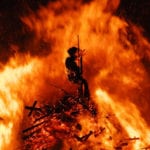 History
History  History
History  Weird Stuff
Weird Stuff 10 Everyday Products Surprisingly Made by Inmates
 Movies and TV
Movies and TV 10 Actors Dragged out of Retirement for One Key Role
 Creepy
Creepy 10 Lesser-Known Shapeshifter Legends from Around the World
 Animals
Animals 10 Amazing Animal Tales from the Ancient World
 Gaming
Gaming 10 Game Characters Everyone Hated Playing
 Books
Books 10 Famous Writers Who Were Hypocritical
 Humans
Humans 10 of the World’s Toughest Puzzles Solved in Record Time
 Mysteries
Mysteries 10 Scientific Mysteries We Don’t Fully Understand
 Weird Stuff
Weird Stuff 10 Celebrities Who Have Admitted to Alien Encounters
 History
History Ten Revealing Facts about Daily Domestic Life in the Old West
 Weird Stuff
Weird Stuff 10 Everyday Products Surprisingly Made by Inmates
 Movies and TV
Movies and TV 10 Actors Dragged out of Retirement for One Key Role
Who's Behind Listverse?

Jamie Frater
Head Editor
Jamie founded Listverse due to an insatiable desire to share fascinating, obscure, and bizarre facts. He has been a guest speaker on numerous national radio and television stations and is a five time published author.
More About Us Creepy
Creepy 10 Lesser-Known Shapeshifter Legends from Around the World
 Animals
Animals 10 Amazing Animal Tales from the Ancient World
 Gaming
Gaming 10 Game Characters Everyone Hated Playing
 Books
Books 10 Famous Writers Who Were Hypocritical
 Humans
Humans 10 of the World’s Toughest Puzzles Solved in Record Time
 Mysteries
Mysteries 10 Scientific Mysteries We Don’t Fully Understand
 Weird Stuff
Weird Stuff 10 Celebrities Who Have Admitted to Alien Encounters
Ten Insane Things That Got Women Accused of Witchcraft
Most of us know the drill with witchcraft accusations. Take a community ravaged by drought, sickness, or religious conflict, add some disenfranchised residents searching for a scapegoat, and the spotlight usually falls on a woman who is already seen as a blight on society. Elderly, unpopular, or poor women were common targets. Of course, most large-scale witch hunts involved accusations against men as well as women—but in every case, the vast majority of the accused, tried, and executed were female.
However, nobody could be arrested simply for being a nuisance. How were these women accused? How did their enemies frame them? Which uncontrollable, random, and often tragic circumstances could be used to send a woman to trial—and often, to her death?
Read on for ten absolutely crazy yet true reasons used as evidence that a woman was a witch.
Related: 10 Ways European Witch Finders Tested Their Victims
10 Being Too Sick to Get Out of Bed and Go to Church
In these Covid days, it’s more than just common courtesy to stay at home if you’re sick—in some places, it’s a legal requirement. Unshockingly, the Puritan residents of the Massachusetts Bay Colony felt a little differently. Everybody was expected to attend church several times a day, often for hours at a time.
Salem resident Sarah Osburn had already caused a local scandal by marrying her much younger indentured servant after her husband died and then claiming her late husband’s property for herself, rather than handing it to her sons as tradition—and her husband’s will—dictated she should. When Abigail Williams and Betty Parris, the alleged victims of witchcraft and two of the original afflicted girls in Salem, both claimed to have been attacked and injured by Osburn, her scandalous past did nothing to help her—and neither did local observations that she had not attended church for three years.
Aged 49, Osburn was in very poor health and essentially bedridden by the time the trials began. She explained her illness to the questioning magistrates. However, she also disclosed that she had once been visited by a “lying spirit” who instructed her to stay away from the church. She insisted that she had disobeyed the spirit’s orders and continued to attend church until she fell ill.
The magistrates were unconvinced and sent her to jail to await trial. Osburn might have found herself the first accused witch to face the hangman, but the filthy, rat-infested Salem jail was no place for an already sick woman. After nine weeks, Osburn died there before she could be tried.[1]
9Featuring in Someone’s Nightmare
In 1661, the Scottish witch trials’ last—and arguably the most deadly—wave took seed in the Lothian region. Elderly midwife Beatrix Leslie of Dalkeith, Midlothian, was a perfect target. She was elderly, argumentative, and she was known to use folk rituals and herbal remedies as part of her practice.
When Leslie was suspected of using dark magic to cause the deaths of two young girls who had angered her, a couple for whom she performed midwife duties came forward to testify against her. They stated that following an argument with Leslie, they experienced violent nightmares in which Leslie attacked and ate them.
Thirty years later, when the permissibility of spectral evidence became a central debate point in the Salem trials (ultimately, it was used and sealed many fates), it was Scottish tradition that was called upon to prove the precedent. Victims would often claim that a specter—a vision of the accused witch or an animal into which she had transformed—had visited in a dream to torture and terrorize them.
Therefore, Leslie’s former clients’ statements were enough for the courts to have her examined by infamous witchfinder John Kindcaid, who first pricked her body in search of the devil’s mark and then forced her to touch the corpses of her victims. Kincaid claimed that the bodies had bled under Leslie’s touch. During the ordeal, Leslie offered her confession, admitting that she had met the devil twice and agreed to be his servant. She was executed days later, in September 1661.[9]
8 Having a Cat Named Satan
Sure, it’s an interesting choice of name, but does that make the owner a witch? In the English town of Chelmsford in 1566, it certainly did.
Elizabeth Francis, an elderly pauper with a poor reputation, was tried for witchcraft three times before being executed. The first time she came before the court, she confessed that she had been given a cat by her grandmother as a child. She claimed that the cat spoke to her, demanding that she feed it drops of her blood. It aided her in killing livestock and humans and instructed her on the use of herbs to induce an abortion after her lover impregnated her.
Unfortunately, the man fell sick and died shortly after Francis consumed the potion, and she was accused of using the cat to kill him. She was found guilty. Stunningly, due to a clerical error, she was sentenced to a year in prison rather than to death. Her sister, Agnes Waterhouse, was not as lucky.
Waterhouse was tried alongside Francis, who claimed that she gifted the cat Satan to Waterhouse. With the cat, Waterhouse also inherited magic abilities, the court claimed. She stood accused of killing her own husband and bringing sickness to several neighbors. Waterhouse admitted that she had instructed Satan to maim a few of her neighbor’s barn animals out of curiosity but denied using the cat, or any black magic, to commit murder.
Her 18-year-old daughter, Joan, who was also on trial, readily testified against her mother to save her own life. She claimed she had heard her mother invoke the devil through the cat and that on several occasions, she herself had tried to exorcise the animal, to no avail. Her testimony earned Agnes an unsavory spot in history as the first woman in England to be executed for witchcraft.[3]
7 Healing a Sick Child
Anna Goldi, a Swiss woman widely accepted as the last person to be executed for witchcraft in Europe, had been through her share of miseries long before she was accused of witchcraft. She had grown up in poverty, twice been impregnated by men who had not married her, and lost one of the resulting babies in early infancy. She was suspected of killing the child and subjected to public humiliation via a stint at the pillory.
In 1780, Goldi took a servant position in the Glarus home of Johann Tschudi, a wealthy physician of high social status. When his children started to find pins in their food, Goldi was accused of attempting to harm them and was dismissed. Within a week, Tschudi’s young daughter had become violently ill—Tschudi later claimed that the child was vomiting pins—and Goldi was brought back to the family home to defend herself against claims that she had bewitched the child.
Local tradition dictated that only the person who made a child sick could heal them, and she was ordered to do so under threat of torture. Miraculously, the child’s health improved under Goldi’s care, but this proved to her employer that it was she who had harmed the little girl, to begin with. She was arrested and tortured, eventually confessing that she had made a pact with the devil to harm the child as revenge for prior misbehavior. She was beheaded in 1782.
In a particularly sad twist, contemporary rumors suggested that Tschudi and Goldi had been lovers. And Tschudi trumped up the charges against Goldi solely to prevent her from spilling the secret and destroying his reputation.[4]
6 Being Identified as a Witch by a Child
Children. The people who believe in fairies and Santa. Their testimony was not only welcomed—it was often sought out. Abigail Williams and the other young afflicted girls of Salem are the best-known examples here, but successful accusations by a child were not unusual. Children were often frightened into telling the adults around them what they wanted to hear; at other times, they accused adults who angered them, perhaps not fully aware of the consequences.
Sweden, a country with a relatively short history of witch trials, experienced one major witch panic in the 1670s, during which several hundred people were executed. Seventy-one of these executions took place in the parish of Torsaker—and all seventy-one victims were identified by children. The process of seeking out the witches unfolded between 1674 and 1675 and was overseen by Laurentius Hornaeus, a bloodthirsty priest who instructed two young boys to linger outside the church and identify witches among the entering congregation.
He advised them that witches had a mark on their foreheads, only visible to the eyes of a child. The boys, terrified by Hornaeus’s fearsome reputation, did what was asked of them. Many other women were arrested that day, and over the coming months, many other children helped Hornaeus in his quest.
Not surprisingly, Hornaeus was not afraid to use physical threats and torture to procure accusations and stories. In the coming months, multiple children accused local women of kidnapping them and taking them to meet with the devil. The hunts culminated in a mass trial and execution, in which one-fifth of the parish’s female population was killed.[5]
5 Being in an Abusive Marriage
Bridget Bishop of Salem was not only argumentative with her neighbors—she argued, frequently and often in public, with her own husband. In Salem, this was a problem. Thomas Oliver was the second of Bishop’s three husbands (this number only added to her problems in the long run) and was widely thought to be abusive. Bishop often fought back. These confrontations occasionally spilled from their home and into public spaces, and although neighbors testified to Oliver’s mistreatment of Bishop, the pair were treated as equally guilty.
After a violent argument occurred on the sabbath day, Oliver and Bishop were each ordered to pay a hefty fine or stand for a day at the pillory. Oliver’s adult daughter paid his fine, but Bishop was subjected to the pillory, ensuring that everyone in Salem was aware of her reputation. When Thomas Oliver became sick sometime later and died, Bishop inherited his entire estate, leaving his children by his first wife with nothing.
Oliver’s children began to suspect Bishop had bewitched and killed him in order to take his property for herself. This was the first occasion on which Bishop faced an official witchcraft accusation, and although she was not found guilty, it did nothing for her reputation. Over the years, she was rumored to be a thief, a drunk, and a bawd, criticized for her bright, elaborate clothing. Her difficult history and her more recent alleged transgressions combined to make her the perfect candidate for the first witchcraft trial. She was swiftly found guilty and became the first victim of Salem’s trials.[6]
4 Losing a Loved One to a Natural Disaster
On Christmas Eve 1617, a furious storm ravaged the ocean surrounding the tiny Norwegian village of Vardo. The men of the town, fishing in a small fleet, perished in the freezing waves. The women, mourning their family members and spouses, were left to fend for themselves. As the northernmost province of the Nordic Counties, Vardo and its neighboring communities had already drawn suspicion from the ruling authorities. The cruel climate often left the landscape shrouded in freezing mist and snow for months at a time, validating a persistent rumor that the entrance to hell could be found in the mountain range south of Vardo.
The area was inhabited by the Indigenous Sami population, who were non-Christian and known to use folk magic in their belief systems. The men of the town often took extended fishing trips, leaving the women and children alone for long periods. Now, the authorities quickly took note of Vardo, a community surviving without men, and suspected the storm had been caused by witchcraft. John Cunningham, a Scottish naval captain, was established as Governor of Finnmark, to reside at the fortress of Vardohus, from where he was to launch a witch hunt.
After interrogation and torture, Vardo resident Mari Jogensdatter confessed that she and several other women of the town had conjured the storm as revenge for neighborly disputes that had gotten out of hand. Several of the women she named confirmed Jogensdatter’s story under torture, stating that they had traveled with her to a witch’s sabbath, where they drank wine and fornicated with the devil. Many of them identified their wealthy neighbor Kirsti Sorensdatter as the coven leader.
Sorensdatter and Jogensdatter were both burned at the stake, inciting Norway’s first major witch hunt. Ninety other women in the community eventually followed them to the stake. But still, the rumors of witchcraft lingered on—Vardo was the focal point of two subsequent witch hunts, during which several hundred more women were killed.[7]
3 Having Argumentative Male Relatives
Rebecca Nurse, age 71, the oldest victim of the Salem trials, was an unlikely candidate for accusation. She was regarded as a pious, kind woman, and both she and her husband were respected community figures in both Salem town and village. However, the couple’s decision to move from the Salem Towne to Salem Village, renting a farming property from a local Reverend, drew them into a land ownership feud between some of the area’s wealthier families.
The dispute was focused on the land between Salem Village and nearby Topsfield, with residents on both sides claiming ownership. Thomas Putnam and several of his brothers had made their homes on the disputed land. They were furious to discover that portions of it were being given to residents of Topsfield—including Rebecca’s brother, Jacob Towne.
When Putnam’s daughter, Ann, claimed affliction by a witch, Putnam used her as a mouthpiece to accuse the family members of the Topsfield men. Rebecca Nurse was among his victims. Her family and neighbors immediately flew to her defense, and she was initially found not guilty at trial. After the afflicted girls became hysterical following the reading of the verdict, the jury was asked to reconsider. The jury amended its verdict—Rebecca Nurse was guilty and sentenced to die. Several other women from prominent Topsfield families were also executed, including Nurse’s sister, Mary.[8]
2 Having Veins in Your Eye
Margaret Aitken, known in her lifetime as the Great Witch of Balwearie, was an unusual but successful Scottish witch hunter. Arrested and accused of witchcraft in 1597, Aitken confessed but persuaded her interrogators that she could not only name other witches she personally knew but also had the power to identify any witch, anywhere. All she had to do was examine the pattern of the veins in a person’s eye.
The notion of the devil’s mark on a witch’s body was nothing new, but the search for it involved removing a victim’s clothes, checking their entire body for suspicious marks, and pricking anything that was found to prove a lack of pain and/or blood. The eye examination was quicker and more efficient.
The authorities, backed enthusiastically by James VI, arranged a national tour of the country and paraded Aitken from town to town, lining up suspected witches for her to examine. Anybody she identified was arrested and tortured into confessing. It is not known exactly how or why Aitken concocted this pretense.
Historians theorize that she was terrified for her own life and seeking to buy herself some time or perhaps escape execution altogether if she was thought to be useful. In the few months before she was revealed to be a fraud, Aitken sent hundreds of women to their deaths. Following her exposure, she, too, was executed.[9]
1 Having a Parent Who Was a Witch—Even if You Were a Child
The third and final Vardo witch trials of 1661–1662 gained traction through accusations made against the children of women previously executed for witchcraft. Sisters Ingeborg and Karen Iversdatter, aged twelve and eight, were brought to Vardohus for questioning in December 1662. Their mother had been burned only months before.
Accompanying them was twelve-year-old Maren Olsdotter, who had lost both her mother and aunt to witch trials. The children were kept in a cell on the estate known as the “witches hole.” No doubt desperate for release, the girls made detailed confessions involving transforming themselves into cats and traveling with other witches to a witches’ sabbath, where they drank wine with Satan. Maren claimed to have taken a tour of hell with an evil spirit.
Although none of the girls could be executed due to their ages, they helped the authorities immensely by implicating adult women, most of whom were then tried and burned. When two accused witches provided witnesses to state that the girls had been threatened with torture, the children were denounced as liars. Maren, who had told the most fanciful stories, was sent to a workhouse while the other girls were freed.[10]








